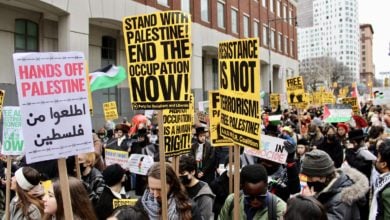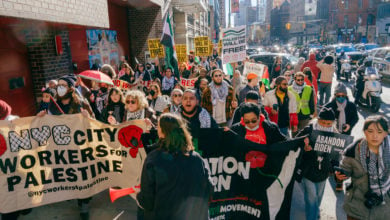“Oftentimes we lose sight of who our real enemies are and give vent to our emotional responses.”1
-Safiya Bukhari
“Circulate, to educate, to liberate!” This was the constant intonation of Sam Napier, circulation manager of The Black Panther newspaper. As one Panther leader noted, Sam was “the main reason” why shortly after it began, the paper had “a 200,000 plus copies per week distribution.”2 Napier was a beloved member of the party, which is why many were taken by surprise when his body was found in March of 1971, tied to a chair, showing bullet wounds and signs of torture. After they left, perhaps while he was still alive, his killers set the building on fire.
Sam Napier was one of the victims of a concentrated effort to destroy the Black Panthers by the U.S. government, as part and parcel of an effort to destroy the entire Black liberation movement and any other radicals who dared raise their voices against the U.S. ruling class and their imperial policies.
COINTELPRO has mainly become synonymous with assassinations and illegal surveillance. What can be overlooked, and certainly is understudied in our social media era, is that the vast majority of COINTELPRO’s “offensive” actions were, in the words of Huey Newton: “to sow dissension.”3
As Black Liberation Army leader Safiya Bukhari stated, “COINTELPRO scored a bull’s eye” with Napier’s death, which was central to its campaign to create an “east coast-west coast” or “Newton-Cleaver” split to debilitate the BPP. The origins of the dispute between the two major Panther leaders was based on diverging assessments of the political moment in the early 70s. The FBI moved aggressively to turn the political split into a deep personal one, using a range of accusations – sent via anonymous or falsely signed letters – to make both sides think the other was looking to kill them and, even worse, may be working with the police.
For the three weeks leading up to Napier’s murder, “a barrage of anonymous letters flowed from FBI field offices in response to the urging from FBI headquarters.”4 Napier sided with Huey Newton once Cleaver was expelled early in 1971. Most New York Panthers, however, supported Cleaver. The situation was extremely tense. Deputy Minister for Defense Robert Webb, who had sided with Cleaver, was murdered a few days before Napier in highly suspicious circumstances during a confrontation with alleged supporters of Newton. Napier was murdered a few days later in what was widely considered retaliation for Webb’s death. By mid-March, just after the murders, the FBI was gloating in internal memos about how they had succeeded in making the “Cleaver-Newton” split “irreconcilable.”5
In addition to sowing dissension within the Panthers, COINTELPRO used similar tactics, in particular fake letters, to sow dissension between the Panthers and other Black organizations. At the height of Fred Hampton’s campaign to win over street organizations to the revolutionary movement, the FBI intervened. FBI agents sent letters to Black P Stone Ranger leader Jeff Fort claiming that the Panthers were constantly insulting him and had placed a hit on him. FBI agents felt this was a “productive” tactic because the Rangers were “violence-prone…shooting, and the like—is second nature.”6
In 1970, after the US organization in Los Angeles had killed two Panthers – John Huggins and Bunchy Carter – the FBI looked to “capitalize on the situation” by having informants make sure US was “appropriately and discreetly advised of the time and location of BPP activities in order that the two organizations might be brought together and thus grant nature the opportunity to take her due course.”7
These episodes show just how devastating state intervention in political disputes can be. It offers an important lesson in how we conduct struggles over “political line.” The more reckless, the more personal, the more potentially damaging the rhetoric used to attack political opponents – this serves to open the door wider and wider for the state to enter and disorganize revolutionary movements.
Big tech and the feds
The danger is especially high with the massive proliferation of anonymous accounts, bot networks and AI generated content. Why are we seeing one post, as opposed to any other? Who determines what is put in front of the most eyeballs? All of this heavily affects the tenor, tone and content of “the discourse.” Obviously, knowledge production and the formation of consciousness on these platforms is not controlled by us, but by the same monopoly capitalist corporations that are our enemies.
These companies are deeply embedded with the state security services of the U.S. government, which direct the flow of content moderation for their own agendas. Twitter, for instance, “directly assisted the U.S. military’s influence operations.”8 The Department of Homeland Security and the State Department, in partnership with Stanford University, made “specific recommendations” on how companies like Facebook, TikTok, Youtube and Reddit “should censor” posts.”9
Even more, one report noted: “Facebook has recruited dozens of individuals from the Central Intelligence Agency (CIA), as well as many more from other agencies like the FBI and Department of Defense (DoD). These hires are primarily in highly politically sensitive sectors such as trust, security and content moderation…TikTok is flooded with NATO officials…former FBI agents abound at Twitter, and…Reddit is led by a former war planner for the NATO think tank, the Atlantic Council.”10
COINTELPRO 2.0
It is naive to assume that the ruling class and its institutions are not attempting to sow dissension in the ranks of the movements challenging capitalism and imperialism today. The real question is, how will our movement respond? Our first defense is organization. Shared communities with common values create the foundations for collective evaluation, struggle and accountability. It creates a counter-pressure to that of social media.
Checking in with your comrades to evaluate the issue from all sides, to speak or respond based on your own strategic goals around your shared values, to consider the implications of the impact of responding or speaking publicly to the broader movements your organization is a part of – all of this is part of security. As Safiya Bukhari notes:
“By definition, security means the freedom from danger, fear and anxiety. Individual and organizational safety and well-being begin with the knowledge of what you’re about, what the organization is about, your limitations, the organization’s limitations, your strengths and the organization’s strengths. Knowledge is the key to security.”11
These are also the communities where we can build trust, sharing our own human side, making us less vulnerable to innuendo and creating greater basis for understanding and forgiveness. Comrade Safiya continues:
“The enemy will use anything and everything they know about you to their advantage. As we shed ego and survive all the knocks of revealing these little truths about ourselves to one another, we become stronger, our organization becomes stronger, and more secure, and our goal becomes realizable because we have begun to sublimate the big ‘I’ to the collective ‘us’ or ‘we.’”12
Former political prisoner David Gilbert offers in his memoirs an experience of dealing with the ultimate betryal, a comrade who, after intense torture and extreme pressure, offered evidence to the police. Recognizing he had not cut a deal but broken under torture, other imprisoned comrades Sekou Odinga and Kuwasi Balagoon offered the indvidual:
“nurture and understanding to regain his sanity. He was obviously broken, visibly trembling in front of the COs and police, but we hoped that with discussion he could come to grips with what had happened. Such openness would enable him to debrief the defense in order to avoid further surprises and to eventually forgive himself and rebuild as a politically conscious person.”13
He notes that unfortunately the person’s
“bravado didn’t allow him to admit that he had broken and talked. Without facing that, he couldn’t rebuild and remained crippled by self-hatred. That dishonesty and fear left the FBI’s hooks still deeply embedded in him.”14
This episode underscores Bukhari’s point about the importance of organization and internal honesty, respect and understanding. Taking these points as foundational, we also must apply history to our current reality.
If totally anonymous accounts are spreading damaging accusations about known and established radical groups or their members, that should give one pause when considering them. Further, individuals who are accountable to nothing tangible and use their platforms to make unverifiable claims and recklessly sow division should also give us pause. Whether someone is ill-intentioned or not, it’s clear that these are exactly the type of practices used to tear down radical movements for decades. That alone is enough to raise a red flag.
Nothing, of course, can solve this problem for us completely and for all time. Every successful movement faces repression and takes certain losses. Organization is the wellspring for successful struggle, hence why state repression focuses first and foremost on weakening our collective institutions. The question is: Can we build organizations that are resilient? One aspect of that is making it as difficult as possible for lies, innuendo, slander and mischaracterization to spread and create resentments that lead to tragedy, like our examples above.
Citations
- https://www.liberationnews.org/black-history-lest-we-forget-by-safiya-bukhari/
- http://www.itsabouttimebpp.com/Memorials/pdf/Remembering_Sam_Napier-February_2012.pdf
- Huey Newton, War Against the Panthers: A Study of Repression in America (1980) https://files.libcom.org/files/WATP.pdf
- Huey Newton, War Against the Panthers: A Study of Repression in America (1980) https://files.libcom.org/files/WATP.pdf
- Ibid.
- Ibid.
- Ibid.
- https://www.newsnationnow.com/business/tech/twitter-aided-pentagon-influence-operations-report/
- https://judiciary.house.gov/sites/evo-subsites/republicans-judiciary.house.gov/files/evo-media-document/EIP_Jira_Ticket_Staff_Report_11-6-23_Clean.pdf
- https://mronline.org/2022/07/14/meet-the-ex-cia-agents-deciding-facebooks-content-policy/
- Safiya Bukhari, The War Before: The True Life Story of Becoming a Black Panther, Keeping the Faith in Prison & Fighting for Those Left Behind (2010) p.37https://ia802802.us.archive.org/21/items/Safiya-bukhari-the-war-before-the-true-life-story-of-becoming-a-black-panther-ke/safiya-bukhari-the-war-before-the-true-life-story-of-becoming-a-black-panther-keeping-the-faith-in-prison-fighting-for-those-left-behind-1.pdf
- Ibid. p.38
- David Gilbert, Love and Struggle: My Life in SDS the Weather Underground and Beyond (2012), pp. 300-301
- Ibid.





